- There is the same amount of water on Earth as there was when the Earth was formed.
- Water is composed of two elements, Hydrogen and Oxygen. 2 Hydrogen + 1 Oxygen = H2O.
- Nearly 97% of the world’s water is salty or otherwise undrinkable. Another 2% is locked in ice caps and glaciers. That leaves just 1% for all of humanity’s needs — all its agricultural, residential, manufacturing, community, and personal needs.
- Water regulates the Earth’s temperature. It also regulates the temperature of the human body, carries nutrients and oxygen to cells, cushions joints, protects organs and tissues, and removes wastes.
- 75% of the human brain is water and 75% of a living tree is water.
- A person can live about a month without food, but only about a week without water.
- Water is part of a deeply interconnected system. What we pour on the ground ends up in our water, and what we spew into the sky ends up in our water.
- Water expands by 9% when it freezes. Frozen water (ice) is lighter than water, which is why ice floats in water.
Water is the most important resource in the world.
Here are 100 amazing facts about water that you may not know.
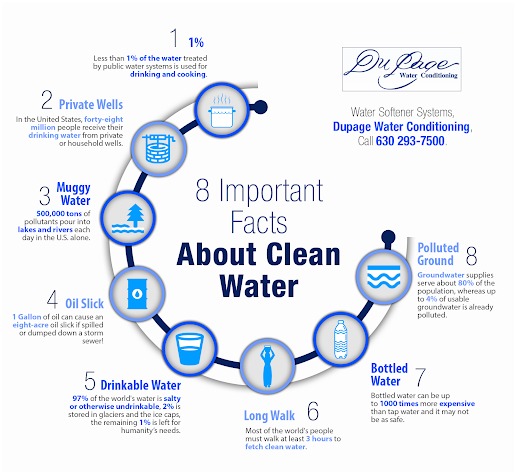
68.7% of the fresh water on Earth is trapped in glaciers.
30% of fresh water is in the ground.
1.7% of the world’s water is frozen and therefore unusable.
Approximately 400 billion gallons of water are used in the United States per day.
Nearly one-half of the water used by Americans is used for thermoelectric power generation.
In one year, the average American residence uses over 100,000 gallons (indoors and outside).
Water can dissolve more substances than any other liquid including sulfuric acid.
The freezing point of water lowers as the amount of salt dissolved in at increases. With average levels of salt, seawater freezes at -2 °C (28.4 °F).
About 6,800 gallons of water is required to grow a day’s food for a family of four.
To create one pint of beer it takes 20 gallons of water.
780 million people lack access to an improved water source.
In just one day, 200 million work hours are consumed by women collecting water for their families.
1/3 what the world spends on bottled water in one year could pay for projects providing water to everyone in need.
Unsafe water kills 200 children every hour.
A jellyfish and a cucumber are each 95% water.
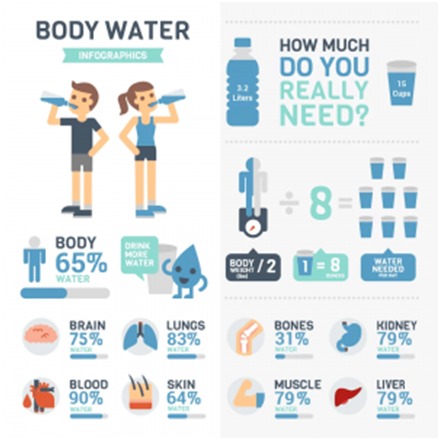
70% of the human brain is water.
80% of all illness in the developing world is water related.
Up to 50% of water is lost through leaks in cities in the developing world.
In Nairobi urban poor pay 10 times more for water than in New York.
In some countries, less than half the population has access to clean water.
$260 billion is the estimated annual economic loss from poor water and sanitation in developing countries.
40 billion hours are spent collecting water in Africa alone.
The average cost for water supplied to a home in the U.S. is about $2.00 for 1,000 gallons, which equals about 5 gallons for a penny.
A person can live about a month without food, but only about a week without water.
Water expands by 9% when it freezes.
There is about the same amount of water on Earth now as there was millions of years ago.
The length of the side of a cube which could hold the Earth’s estimated total volume of water in km = 1150.
Children in the first 6 months of life consume seven times as much water per pound as the average adult.
85% of the world population lives in the driest half of the planet.
Agriculture accounts for ~70% of global freshwater withdrawals (up to 90% in some fast-growing economies).
Various estimates indicate that, based on business as usual, ~3.5 planets Earth would be needed to sustain a global population achieving the current lifestyle of the average European or North American.
Number of states are anticipating water shortages by 2025.
1 in 6 gallons of water leak from utility pipes before reaching customers in the US.
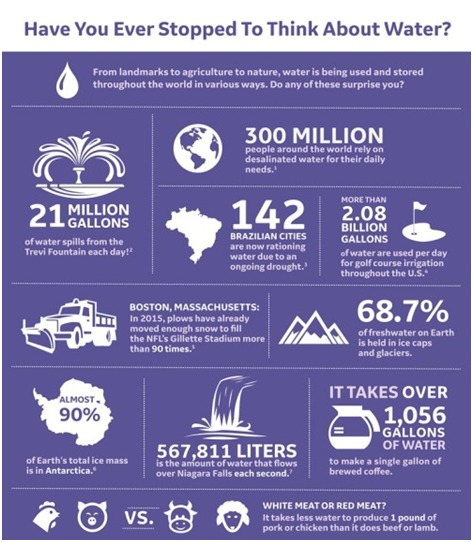
American use 5.7 billion gallons per day from toilet flushes.
Refilling a half-liter water bottle 1,740 times with tap water is the equivalent cost of a 99 cent water bottle at a convenience store.
It takes about 12 gallons per day to sustain a human (this figure takes into account all uses for water, like drinking, sanitation and food production).
Each day, we also lose a little more than a cup of water (237 ml) when we exhale it.
By 2025, water withdrawals are predicted to increase by 50 percent in developing countries and 18 percent in developed countries.
By 2025 half the world’s people will live in countries with high water stress.
A water-efficient dishwasher uses as little as 4 gallons per cycle but hand washing dishes uses 20 gallons of water.
The average family of four uses 180 gallons of water per day outdoors. It is estimated that over 50% is wasted from evaporation, wind, or overwatering.
It takes more than twice the amount of water to produce coffee than it does tea.
Hot water can freeze faster than cold water under some conditions (commonly known as the Mpemba effect).
If the entire world’s water were fit into a 4 liter jug, the fresh water available for us would equal only about one tablespoon.
Over 90% of the world’s supply of fresh water is located in Antarctica.
Water regulates the Earth’s temperature.
On average, 10 gallons per day of your water footprint (or 14% of your
indoor use) is lost to leaks.
The average pool takes 22,000 gallons of water to fill.
It takes about 70 gallons of water to fill a bathtub.
Flying from Los Angeles to San Francisco, about 700 miles round-trip, could cost you more than 9,000 gallons of water.
Water use has grown at more than twice the rate of population increase in the last century.
Only 0.007 percent of the planet’s water is available to fuel and feed its 6.8 billion people.
Three quarters of all Americans live within 10 miles of polluted water.
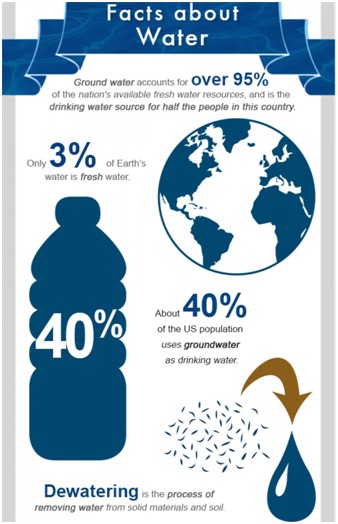
A swimming pool naturally loses about 1,000 gallons (3,785 liters) a month to evaporation.
40% of freshwater withdrawals in the United States are used for agriculture. 80% of freshwater withdrawals in India are used for agriculture.
Freshwater withdrawals for agriculture exceed 90% in many countries: Cambodia 94%, Pakistan 94%, Vietnam 95%, Madagascar 97%, Iran 92%, Ecuador 92%.
If everyone in the US used just one less gallon of water per shower every day, we could save some 85 billion gallons of water per year.
Over 42,000 gallons of water (enough to fill a 30×50 foot swimming pool) are needed to grow and prepare food for a typical Thanksgiving dinner for eight.
An acre of corn will give off 4,000 gallons of water per day in evaporation.
In a 100-year period, a water molecule spends 98 years in the ocean, 20 months as ice, about 2 weeks in lakes and rivers, and less than a week in the atmosphere.
Water is the most common substance found on earth.
In Washington state alone, glaciers provide 1.8 trillion liters (470 billion gallons) of water each summer.
Water makes up about 66 percent of the human body.
Drinking too much water can be fatal (known as water intoxication).
There is more fresh water in the atmosphere than in all of the rivers on the planet combined.
If all of the water vapor in the Earth’s atmosphere fell at once, distributed evenly, it would only cover the earth with about an inch of water.
263 rivers either cross or demarcate international political boundaries.
Of the estimated 1.4 billion hectares of crop land worldwide, around 80 percent is rainfed and accounts for about 60 percent of global agricultural output (the other 40% of output is from irrigated crop land).
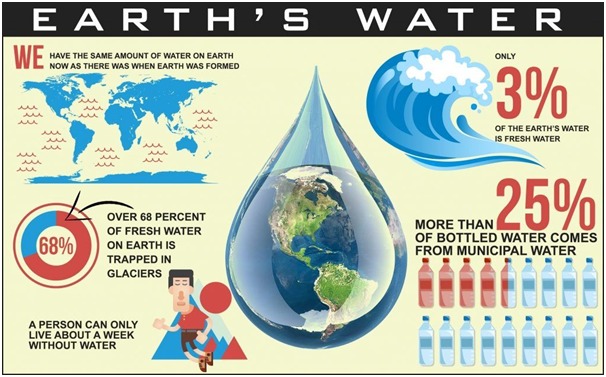
Household leaks can waste more than 1 trillion gallons annually nationwide. That’s equal to the annual household water use of more than 11 million homes.
Ten percent of homes have leaks that waste 90 gallons or more per day.
A leaky faucet that drips at the rate of one drip per second can waste more than 3,000 gallons per year.
Each cubic foot of Martian soil contains around two pints of liquid water, though the molecules are not freely accessible, but rather bound to other minerals in the soil.
There is an estimated 326 million trillion gallons of water on earth.
NASA has discovered water in the form of ice on the moon.
A 2.6 billion year old pocket of water was discovered in a mine, 2 miles below the earth’s surface.
Two-thirds of the world’s population is projected to face water scarcity by 2025, according to the United Nations.
1 pound of beef requires 1,799 gallons of water.
1 gallon of wine requires 1,008 gallons of water.
A 0.3 pound burger requires 660 gallons of water.
1 slice of bread requires 11 gallons of water.
1 apple requires 18 gallons of water.
1 pound of chocolate requires 3,170 gallons of water.
500 sheets of paper requires 1,321 gallons of water.
Ground water occurs almost everywhere beneath the land surface. The widespread occurrence of potable ground water is the reason that it is used as a source of water supply by about one-half the population of the United States.
At any given moment, groundwater is 20 to 30 times greater than the amount in all the lakes, streams, and rivers.
The High Plains Aquifer covers eight states and 175,000 miles.
Collect the water from rain,
let it run into the earth again
Vardhman Envirotech,
India’s Passionate Rainwater Company
